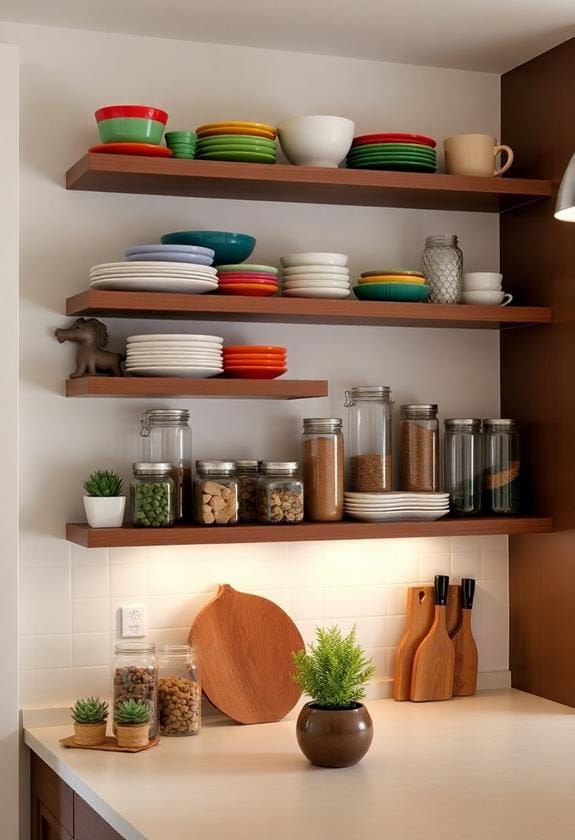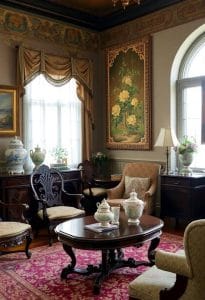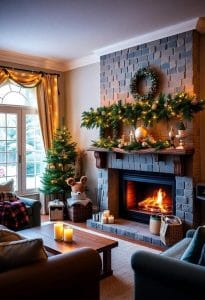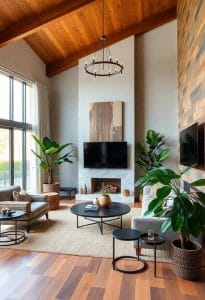To style open shelving beautifully, start with a color scheme that complements your existing decor, using neutral tones as a backdrop and adding pops of color with decorative items. Balance elements by mixing shapes and sizes, pairing taller objects with smaller ones, and leaving some empty space for flow. Introduce greenery for freshness, choosing plants that suit the lighting. Vary object heights to create depth, placing taller items at the back. Personal touches, like framed photos or travel souvenirs, add warmth and individuality. By applying these strategies, your shelves can become engaging focal points for your space, inviting further exploration.
Key Points
- Select a cohesive color scheme with neutral tones and pops of color to complement the decor.
- Balance decorative elements by mixing shapes, sizes, and materials while leaving empty spaces for flow.
- Incorporate various heights by placing taller items at the back and staggering heights for depth.
- Add greenery with plants of different sizes in complementary pots for freshness and visual interest.
- Include personal touches like framed photos and souvenirs to personalize the space.
Choose a Color Scheme

When styling open shelving, kicking off with a well-thought-out color scheme can make all the difference. Start by choosing a palette that complements the room's existing decor, ensuring a cohesive and polished appearance. Consider using a mix of neutral tones as your base, such as whites, grays, or beiges, which provide a versatile backdrop for more vibrant accents. This approach allows you to incorporate pops of color through decorative items like vases, books, or artwork, adding visual interest without overwhelming the space. For those looking for stylish decor tips, integrating textures and materials can also enhance the visual appeal of your shelves.
Next, think about the mood you want to create. Soft, muted colors can evoke a calm, serene atmosphere, while bold, contrasting hues might energize the room. Whatever your choice, consistency is key—stick to a limited range of colors to avoid a cluttered look. You can also play with different shades of the same color to add depth and dimension while maintaining harmony.
As you arrange items, consider how their colors interact. Group similar tones together to create blocks of color that draw the eye, or alternate shades for a more dynamic effect. By thoughtfully selecting and organizing colors, you'll enhance the overall aesthetic of your open shelving.
Balance Decorative Elements
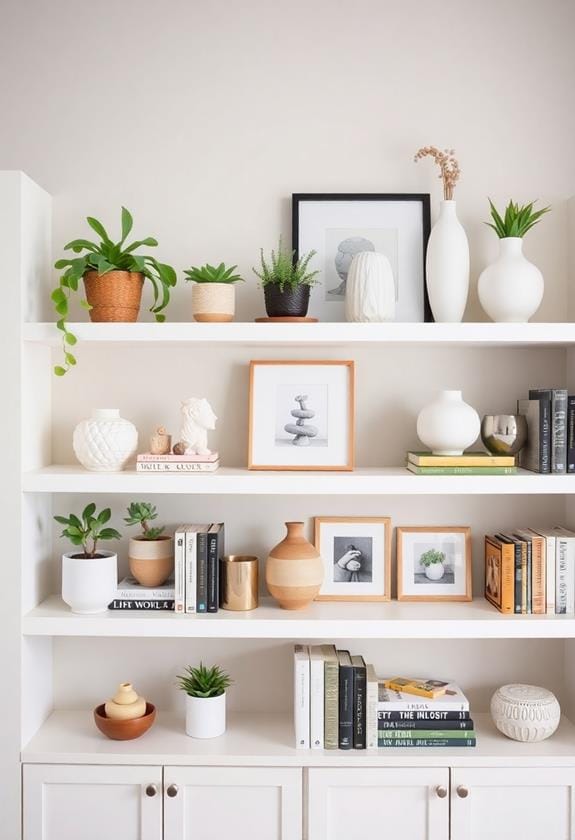
Achieving balance with decorative elements on your open shelving can transform the space into a visually pleasing area. Start by mixing different shapes and sizes of items to create interest and cohesion. Consider pairing taller objects, like vases or candlesticks, with smaller ones, such as books or framed photos, to add dimension. For more inspiration for your home, you might explore different themes or color palettes that suit your style. Be careful not to overcrowd the shelves; leaving some empty space can help your eye move naturally from one element to the next.
Think about symmetry when arranging your items. You don't have to make everything perfectly even, but placing similar objects on opposite ends can provide a sense of equilibrium. For instance, if you have a large sculpture on one side, balance it with a group of smaller items on the other. This technique guarantees that no single section feels heavier than the rest.
Texture also plays an essential role in achieving balance. Combine materials like glass, wood, and metal to create a layered look that's both engaging and harmonious. Mixing textures keeps the display from feeling flat or monotonous. By thoughtfully arranging these elements, you'll create an open shelving display that's not just functional but also a true reflection of your personal style.
Incorporate Greenery
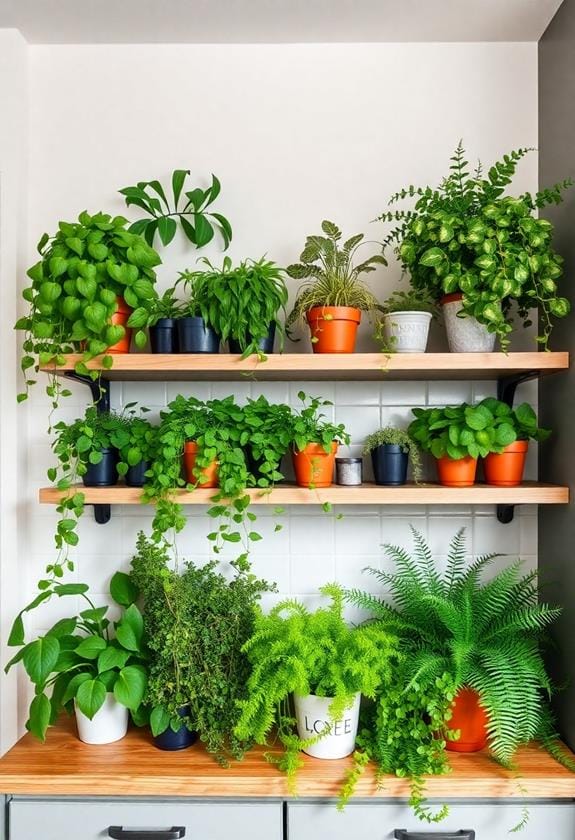
Adding greenery to your open shelving can breathe life into the space, creating a revitalizing and vibrant atmosphere. Plants introduce a sense of freshness and natural beauty, breaking the monotony of static objects. When you incorporate greenery, you're not just adding decoration; you're inviting a touch of nature that can transform the room's energy. For those interested in feng shui indoor plants, incorporating specific types of plants can also enhance the flow of positive energy in your home.
Start by choosing plants that suit your environment. If your shelves are in a well-lit area, opt for sun-loving plants like succulents or small ferns. For low-light spaces, consider pothos or snake plants, which thrive with minimal sunlight. The key is to select plants that will flourish in your specific conditions to guarantee they remain lush and healthy.
Consider using a mix of plant sizes to create visual interest. Small pots can be nestled among books and decorative items, while trailing plants can cascade down for a stunning effect. Remember to use pots and planters that complement the overall decor of your shelves, maintaining harmony between your greenery and other elements. With the right selection and placement, plants can effortlessly enhance the aesthetic appeal of your open shelving, making it a focal point in your home.
Utilize Varied Heights
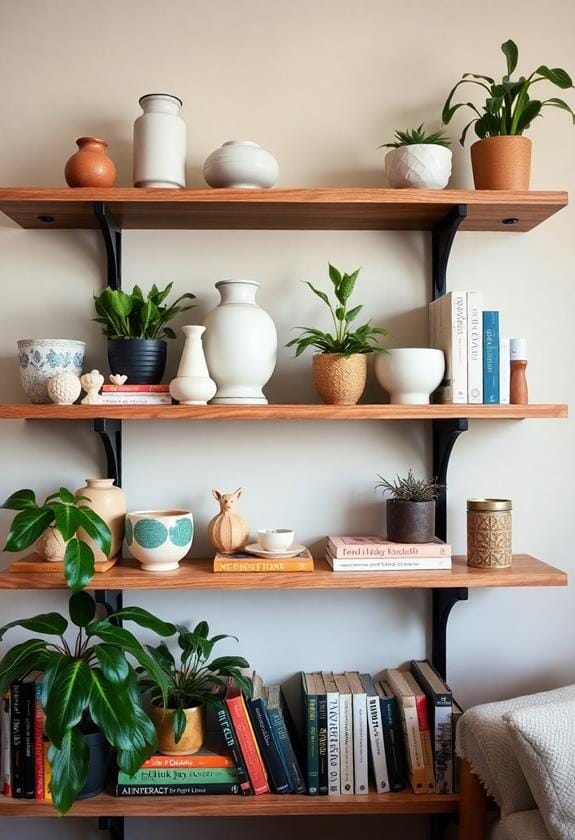
To elevate the aesthetic of your open shelving further, consider playing with varied heights. This technique can create visual interest and add depth to your display. Start by mixing objects of different sizes and shapes; this approach prevents your shelves from looking flat or monotonous. For instance, you might pair a tall vase with a shorter stack of books or place a small sculpture next to a large picture frame. This variation not only draws the eye but also helps balance the composition.
When arranging items, think of the shelves as a canvas where you're creating a dynamic scene. Use taller items at the back and shorter ones in the front to create layers. This method enhances the perception of depth, making your shelves appear more curated and intentional. You can also stagger heights along the length of the shelf, creating a gentle wave-like effect that guides the viewer's eye across the space.
Add Personal Touches
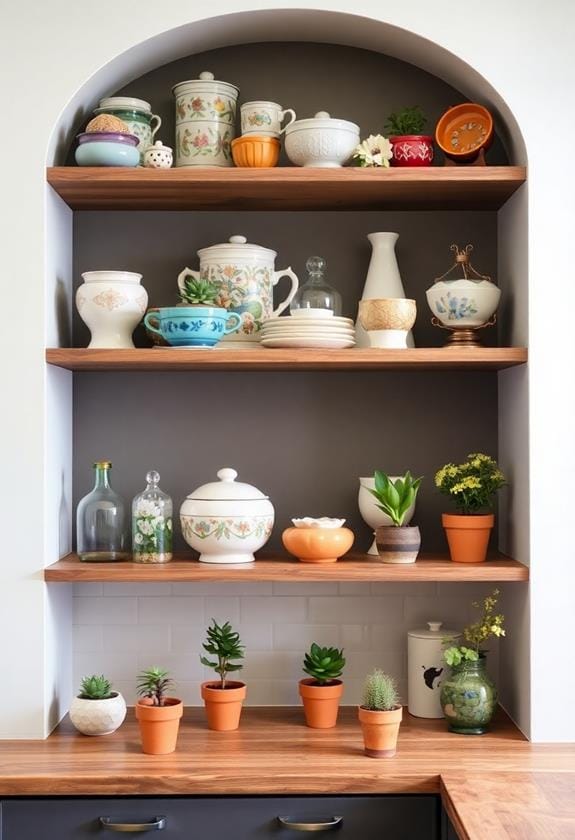
Infusing personal touches into your open shelving can transform it from merely functional to a true reflection of your individuality. By incorporating items that hold sentimental value or tell a story about you, the shelves become more than just a storage solution; they become a display of your life and interests. Consider adding elegant pieces like a ceramic jewelry tray or colorful LED lights to enhance the aesthetic. Start by choosing objects that resonate with you, be it items from your travels or gifts from loved ones. Balance is key, so aim for a mix of textures and colors to create visual interest without overwhelming the space.
To get started, consider these ideas:
- Framed Photos: Showcase cherished memories with family and friends to add warmth and personality.
- Heirlooms: Display meaningful items passed down through generations, connecting the past with the present.
- Travel Souvenirs: Incorporate mementos from your adventures, reminding you of experiences and places you've loved.
- Handmade Crafts: Add a touch of creativity with items like pottery or art you've created yourself.
- Books: Include a selection of your favorite reads or beautifully bound editions, offering insight into your interests.
Blending these personal elements with your decor creates a unique and inviting space that truly feels like home.
Frequently Asked Questions
How Do I Prevent Open Shelving From Looking Cluttered?
To prevent your open shelving from looking cluttered, start by curating items carefully. Limit the number of pieces, focusing on those that are both functional and aesthetically pleasing. Group similar items together for a cohesive look, and use baskets or boxes to contain smaller objects. Balance is key, so distribute weight evenly across the shelves. Regularly reassess and remove unnecessary items, ensuring that every piece has a purpose or adds charm.
What Materials Are Best for Durable Open Shelving?
Did you know that over 60% of homeowners prefer wood for their open shelving due to its durability and aesthetic appeal? When you're thinking about materials, wood is a top choice because it's both sturdy and versatile. Metal can also be great if you're aiming for a modern or industrial look, offering robustness and sleekness. Consider glass for a lighter, airy feel, but be cautious, as it's less forgiving with weight and impact.
How Can I Ensure My Open Shelves Remain Dust-Free?
To keep your open shelves dust-free, regularly dust them with a microfiber cloth, which efficiently captures particles without spreading them around. Consider placing items you use frequently on them; this naturally reduces dust accumulation. You can also use a gentle vacuum attachment to reach tight spaces. Investing in air purifiers can greatly reduce airborne dust. Remember, consistent maintenance is key, so set a regular cleaning schedule to keep your shelves pristine.
Are Open Shelves Suitable for Small Spaces?
Open shelves can transform small spaces by adding storage, enhancing accessibility, and showcasing personality. You maximize vertical space, create the illusion of depth, and keep essentials within easy reach. However, you'll need to curate carefully to avoid clutter, maintain balance, and guarantee stability. Choose sturdy materials, mix decorative items with functional pieces, and regularly rotate displays. With thoughtful arrangement, you'll find open shelving not only practical but also visually appealing in compact areas.
How Do I Securely Install Open Shelves on Different Wall Types?
To securely install open shelves, you've got to contemplate the wall type first. For drywall, use anchors or toggle bolts to guarantee stability. On brick or concrete, a masonry bit and anchors are essential. If it's a stud wall, find the studs using a stud finder and screw directly into them. Each method requires proper tools and safety precautions, so don't rush the process to make sure your shelves hold well.

